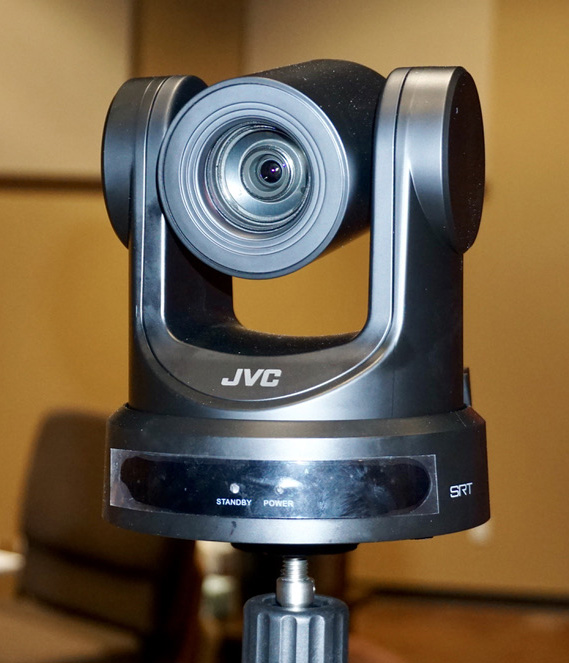
Since its introduction by NewTek in 2015, NDI (Network Device Interface) has revolutionized and simplified AV-over-IP signal transport.
[One Standard to Rule Them All?]
In strict terms, “NDI is a video connectivity protocol that allows any two devices or a device and a software on a computer to exchange audio, video, and metadata,” explained Miguel Coutinho, NDI’s head of strategy. “What makes it so successful is the ability of any software company to adopt NDI or to support NDI free of charge.”

The fact that NDI is a free-to-use open AVoIP standard is one reason why this video connectivity protocol has been adopted by major AV and IT equipment manufacturers industry-wide. They wouldn’t have adopted NDI if it didn’t work—but it does.
“On the end user side, I would say NDI is probably the easiest to use and most effective video over IP protocol that's out there,” Coutinho said. “This doesn't mean that NDI should be the go-to solution if you are looking to deploy something on a 12 gig network. But it is the connectivity technology that covers the most use cases and allows you to do more with more flexibility and less costs.”
[Editorial: Can NDI Become Ubiquitous?]
When NewTek was acquired in 2019, NDI became part of the Vizrt Group. At press time, the industry was awaiting the release of NDI 6, the latest iteration of the widely-used AVoIP standard. Limited beta testing via select partners has been in progress for months, and a public beta version is expected soon. While we wait, here’s a deeper dive on what makes NDI so popular.
Formula for Success
Edgar Shane is general manager of engineering and product development with JVC Professional Video. He likes NDI because, unlike other protocols, it features a "plug-and-play configuration where all sources [cameras, encoders, PCs, etc.] can be automatically discovered by NDI-capable video players, decoders, and video switchers. No IP or port configuration is needed, provided all sources are connected to the same LAN.”

Where NDI really comes to the fore, he added, is as an easy-to-use replacement for peer-to-peer SDI connections for live video production. “Using the existing LAN, NDI allows automatic discovery and one-to-one or one-to-many AV connections among multiple cameras and video mixers via a single Ethernet cable,” Shane explained. “Simplicity and low cost of implementation are the biggest driving factors for implementing NDI workflows. A single Ethernet cable carries bidirectional AV and camera control signals via standard IT infrastructure. No additional wiring or switching is required, while multiple IP protocols can co-exist on LAN, including NDI and Dante.”
NDI’s many advantages explain why JVC has integrated the protocol into its cameras and video mixers. “NDI provides our customers with a simple and cost-efficient workflow and ensures interoperability with many other brands of production equipment,” Shane added. “Most recently, this included a collection of remote production solutions that provide our customers with high-quality, price-effective, glass-to-glass tools. With these latest solutions, broadcasters, houses of worship, and event facilities of all sizes can stay competitive in our evolving media market.”
ENCO Systems employs NDI in its automated/real-time captioning and TV-channel-in-a-box broadcast software solutions. “Part of what makes any standard really take hold is its accessibility across different systems and reliable integration with other products,” said Bill Bennett, ENCO’s media solutions and accounts manager. “NDI has been around for a while, is supported well, and is regularly updated—all crucial when it comes to staying powerful. Its further development by adding useful, cloud-friendly, and cross-platform NDI Tools only further improves its usefulness for all kinds of applications where affordable, high-quality AVoIP transport is essential. From a cost standpoint, being royalty-free has also opened a lot of doors.”
A History of Progress
NDI has gone out of its way to give equipment and software makers the freedom to manage and advance the AVoIP standard directly, rather than enforcing direct control itself. “We want to be decentralized, meaning we want NDI to be supported by as many software companies as possible. We don't want to be a middleman where, if you buy a full set of NDI-enabled equipment, you are then supposed to come back to us, pay for our software, and be locked to whatever we think is the best set of features or user interface," Coutinho explained. "I would say that's the main difference between us and our competitors.”

NDI’s willingness to share has made this standard extremely compelling to companies like ENCO. “Without question, the low/zero cost to employ NDI and its ever-growing suite of tools make it a hard option to pass up,” said Bennett. “Native integration into more applications makes using NDI seamless to workflows, and their interfaces have become very user-friendly, meaning even non-technical users can set up NDI transmitters and receivers or use their tools easily.”
Since NDI was introduced at IBC 2015 by Dr. Andrew Cross (the driving force behind the standard and recent inductee into the SCN Hall of Fame), the protocol has been regularly revised, expanded, and improved. Case in point: “NDI was originally based on the I-frame SpeedHQ codec and required a high bandwidth for AV transfer,” recalled Shane. “The NDI HX/HX2/HX3 variants introduced later feature H.264 and HEVC codecs for significant bandwidth reduction to accommodate multiple HD and 4K streams over standard Gigabit networks."
[See How Prudential Financial Made a Smart AV Investment]
NDI appeared when the concept of streaming was alien and unfamiliar to many end users. “Running audio—let alone video—over Ethernet was a very disruptive concept at first, and it still is evolving and gaining trust in new markets,” Bennett said. “When NDI came out in 2016, it was fairly simple. Major quality, discovery, and routing improvements and tools came later in its successive versions, only enhancing NDI’s usefulness. The latest additions of a router, support for 4K, smartphone apps, and webcam make it even more useful throughout a workflow.”

NDI Bridge is another development; it is designed to interconnect multiple NDI domains via WAN and the internet. “NDI's latest enhancements make it more useful in cloud workflows,” Bennett added. “Right now, many churches, municipalities, streamers, radio stations, and live event producers use NDI entirely within their private LANs. However, once the ease at which NDI enables cloud-based and internet workflows becomes more commonly known, many users may start adding those remote capabilities to their local productions.”
This history of progress will continue when NDI 6 is released—and Coutinho is excited by its prospects. He expects to see NDI being deployed more in office settings, medical facilities, video games, and prosumer AV equipment.
“NDI 6 is the first true release of this new stage of NDI as a standard and as a company, because it'll open a door for better and more native integration of NDI on compact form factors, starting with camera devices,” he said. “It will also meet expectations in terms of increased video image quality that our user base is looking for, both for small video operations and national TV networks.”







